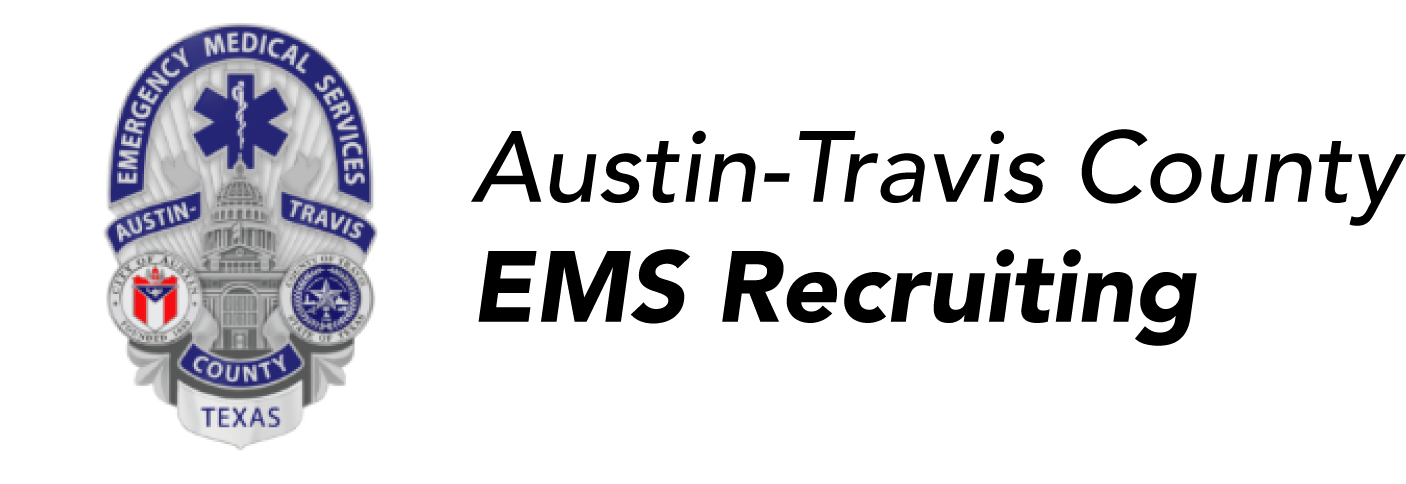Innovation
Our EMS system was originally seen as a system to respond to acute life-threatening emergencies, but responding to emergencies only makes up 14% of the work we do on a regular basis. Over 70% of our work is providing necessary medical care to patients. In Austin, EMS plays a larger role in improving health beyond the traditional resuscitating and delivering patients to the emergency department. Over the past decade, we’ve expanded our programs and services to include solutions to integrate public health and EMS in an effort to help build community resilience and reduce dependency on emergency services.
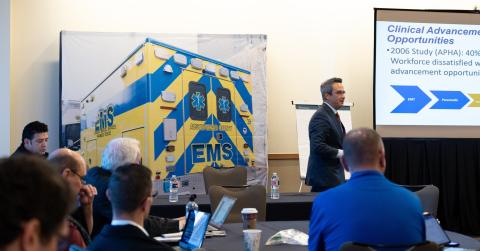
CAAS ACCREDITED (COMMISSION ON ACCREDITATION OF AMBULANCE SERVICES)
Austin-Travis County EMS is proud to hold CAAS accreditation. The accreditation process has served as an imperative way of educating our management and sworn staff of the need to continually evaluate and improve our organization’s performance. It seemed to be a natural extension of our commitment to providing a higher level of Emergency Medical Services to our community and our patients.
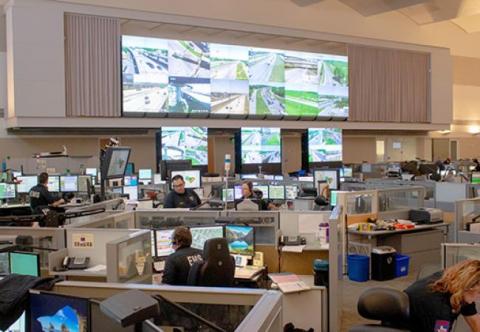
INTERNATIONAL ACADEMIES OF EMERGENCY DISPATCH ACCREDITATION
Austin-Travis County EMS was the 1st International Academies of Emergency Dispatch Accreditation (IAED) Accredited Center of Excellence (ACE) in Texas and the 39th in the world. ACE status ensures maximum accuracy, effectiveness, and efficiency of emergency call systems and sets the quality of public safety and patient care to the highest standard. This accreditation supports our department's drive to provide the highest standard of care across the board. We are proud to say that our Communications section has maintained this accreditation for over 12 years.
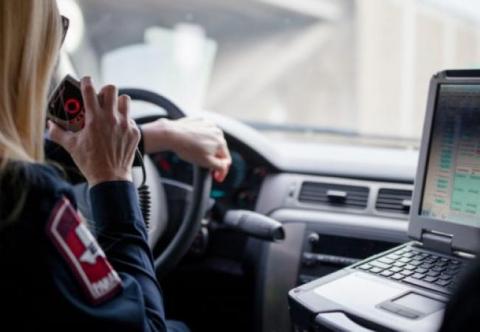
COMMUNITY HEALTH PARAMEDIC PROGRAM
Austin-Travis County EMS (ATCEMS) has had a Community Health Paramedic Program (CHP) for over 15 years. In 2006, ATCEMS recognized there was a need to develop new ways to serve individuals who call 911 for non-emergent problems or conditions that could be better addressed by other services; their primary care doctor, a mental health professional or urgent care.
- Read More
-
That same year the department began investigating ways to work collaboratively with representatives from the hospitals, clinics, mental health agencies and law enforcement. The idea was to assess and develop new ways of providing more individualized and intensive services to reduce the individual’s reliance on the 911 emergency system. This led to the development of many partnerships with various agencies in the community that typically had not partnered with EMS to deliver service. Streamlining communication and collaboration between these agencies was crucial to providing the patient the right care, at the right time, from the right provider. Along the way, the medics identified additional gaps in the healthcare and mental healthcare systems that EMS was strategically positioned to address. This work would be the birth of what today is ATCEMS’s CHP Team.
The CHP Mission is to improve the health equity and healthcare options for underserved and vulnerable populations in Travis County through innovative utilization of the unique skills and talents of our Community Health Paramedics in order to help individuals proactively and preventatively manage their healthcare needs.
Today, the CHP Team has evolved to a team of 32 providers and one Commander who work independently to address health related needs and problems of the community. Needs such as taking care of non-emergent medical problems, getting patients set up with a primary care doctor or connecting them to and providing mental health services. CHP team members can often be found working with a variety of health care and social service providers such as social workers, doctors, mid-level practitioners, police officers and case managers providing medical care and assisting patients navigating the health care system.
The overall goal of the CHP is to help people manage their medical and mental health in a proactive manner that keeps them from relying on 911. CHP along with services such as Community Care, Integral Care, Central Health and many other organizations work collaboratively to remove barriers to health care.
For a CHP Team medic every day is different. CHP team members meet with individuals wherever they may be, at home, on the streets, at shelters and while incarcerated. Some respond to 911 calls along with traditional response units (or in place of those units) to provide unique solutions. Others work as Case Managers meeting with patients and clients on a more scheduled basis. While working with the individual, CHP medics assess their physical and mental health, identify essential medical needs and develop a patient care plan focused on addressing the needs of the whole person and getting them the appropriate care.
While carrying out the patient care plan that has been developed, the CHP medic monitors the health of the patient, relaying information to other medical professionals and alerting them of issues that may need to be addressed before they become emergencies, such as a significant change in their physical or mental health. By assuming this role in the community, CHP medics often serve as the “eyes and ears” for other health care providers that also want to keep the patient healthy. In some cases, such as with opiate users who are ready to begin treatment for their addiction, CHP medics provide immediate medical treatment that is otherwise not available in the healthcare community and continue the treatments until the patient can start a formal treatment program.
Moving forward, the goal is to utilize the CHP Team to address non-emergent needs for individuals that call 911 because they have no other place to turn for medical care or mental health crises. We are also partnering with clinics, hospitals and other resources to develop ways to prevent hospital readmissions and ensure the patient is receiving the most appropriate care.
CHP medics are well positioned to become the next generation of paramedics and EMT’s that respond to 911 calls, determine the most appropriate care and get them connected with that resource. These resources may not be hospital emergency departments, instead they may be urgent care centers, clinics, telemedicine, or treatment at the point-of-contact with the patient.
Programs provided by CHP include:
High Utilizer Group (HUG) and HUG-Prevention People Experiencing Homelessness (PEH) Support Program which includes:
- Homeless Outreach Street Team (HOST)
- Street Med Collaboration
- Pop-up Resource Clinics (PURCs)
For more information about the programs, including eligibility and how to refer someone who may be eligible and in need, visit our CHP Resource Page.
- Controlled Populations Program
- Opioid Use Disorder (OUD) Support Program
- Buprenorphine Bridge Program
- Re-Admission Prevention Program
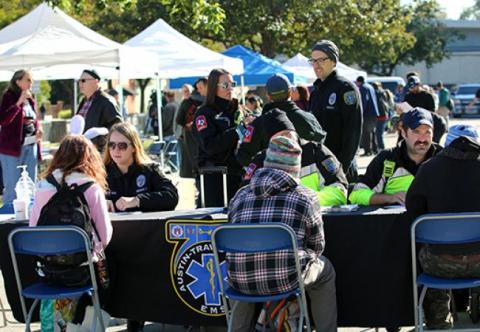
POP-UP RESOURCE CLINIC
The Community Health Paramedic (CHP) Program has recently launched a mobile health resource hub called Pop-Up Resource Clinics (PURCs-pronounced perks). Historical information can be gathered through the 911 system to map out geographical locations where PURCs would have the greatest benefit. Once locations have been identified, the CHP team is able to schedule a PURC in those areas. The PURCs allow all agencies to be in one location and the CHP team is able to direct individuals to services such as full medical exam, prescription access, mental health care and the county Medical Access Program (MAP).
ATCEMS Community Health Paramedics partner with Central Health Texas and community clinics to provide Pop-Up Resource Clinics and have had great response and participation.
HOMELESSNESS INITIATIVE
Under the CHP mission statement the Homeless Initiative seeks to provide for the healthcare options and health equity of persons experiencing homelessness in our community. As part of the program, one CHP medic is assigned as part of the HOST (Homeless Outreach Street Team) which proactively addresses population needs in the downtown area. Another CHP medic is assigned to THOR (Targeted Homeless Outreach Response) activities, which addresses the needs of homeless people outside the downtown area, focusing on areas with large 911 or public involvement.
The Street Med Collaboration is a joint effort between CHP and the Street Med team within the Community Care Clinics. This group brings primary care directly to people in homeless encampments. They conduct assessments, write and deliver prescriptions, arrange medical funding, and address minimal needs all within the locations the patients reside. The PURC (Pop-up Resource Clinic) program is a regularly scheduled series of events intended to bring the resources to a centralized location to address the needs of persons experiencing homelessness.
